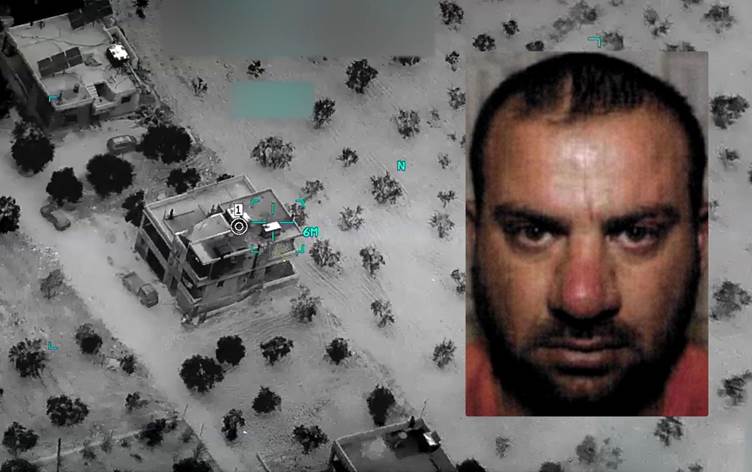
Pre-operation image (left) of building housing ISIS leader Abu Ibrahim al-Hashimi al-Qurayshi (right) in northwest Syria prior to a raid executed by US forces. Photo: US Department of Defense/AFP; Graphic: Rudaw
ERBIL, Kurdistan Region - Several US helicopters hovered over the Syrian sky in the early hours of Thursday morning followed by calls of evacuations directed at a three-story building housing civilians and the leader of an armed terror group. The call-outs were silenced by a massive explosion that destroyed the top floor, leaving dozens dead.
With intent to capture the head of the Islamic State (ISIS), long-range American helicopters raided the rebel-held Idlib province in northwest Syria. As US forces isolated the building housing the leader, they requested the occupants inside to evacuate the property.
A blast shook the third level as civilians were walking out of the building. The leader of the terror group, Abu Ibrahim al-Hashimi al-Qurayshi, had detonated a suicide bomb killing everyone on the floor, including members of his family.
“On arrival at the objective, US forces isolated the three-story building in which he [Qurayshi] was known to be hiding. When US forces began call outs, asking for occupants to evacuate the building … a massive explosion occurred on the third floor of the building,” Commander of US Central Command General Kenneth F. McKenzie told the Middle East Institute (MEI) over a Zoom call following the attack on Thursday.
Six civilians had evacuated the building before the explosion occurred, McKenzie noted.
ISIS swept across Iraq and Syria in the summer of 2014. Minority groups especially suffered under the terror group's rule, including Yazidis, Shabaks, and Christians. A United Nations investigation concluded in May that evidence shows ISIS committed genocide against the Yazidis.
“As US forces continued inside the building and began making call-outs to the second floor, two barricaded combatants hiding among children began firing at US forces. In this engagement, one child was found dead along with the two combatants,” McKenzie said while describing the details of the operation.
“While the second-floor clearance was underway, multiple fighters assessed to be linked to local Al-Qaeda affiliates in Syria began maneuvering with weapons towards US forces on the objectives. At least 2 of these fighters were killed in a gun engagement from a helicopter in defense of US forces,” he added.
The US forces found the ISIS leader dead on the ground outside the building due to the force of the self-initiated explosion. Fingerprint and DNA analysis confirmed that the body belonged to Qurayshi, McKenzie said. Twelve other people were also reported dead.
Qurayshi, referred to as Haji Abdullah by US officials, was hiding in Atmeh town in Idlib, around 15 kilometers north of where his predecessor Abu Bakr al-Baghdadi blew himself up in a US special forces raid in October 2019. He was considered a low-profile but brutal operator, who had largely flown under the radar of Iraqi and US intelligence until that point, according to the AFP.
The United States had placed a $10 million reward on Qurayshi’s head when he took the ISIS helm.
The deceased leader “was actually far more of an operational planner and a director of operations. He was directly or indirectly responsible for numerous atrocities, including those against the Yazidis early on and ISIS reign of terror in Iraq and Syria,” the US official said.
He “did not fight. He killed himself and his immediate family without fighting, even as we attempted to call for his surrender and offered him a path to survive,” McKenzie added.
US President Joe Biden announced the death of Qurayshi on Thursday, saying a global “terrorist threat” had been removed and that the raid was carried out instead of an airstrike to “minimize civilian casualties.”
Qurayshi “had chosen to surround himself with families, including children, we made a choice to pursue a special forces raid at a much greater risk to our own people, rather than targeting him with an airstrike," President Biden said.
ISIS militants launched their biggest assault since the defeat of its so-called caliphate nearly three years ago in Syria, attacking al-Sina’a prison in northeast Syria (Rojava) to free fellow members and affiliates. The offensive sparked battles between the Kurdish-led forces and the terror group that left over 370 dead.
Additional reporting by Julian Bechocha








Comments
Rudaw moderates all comments submitted on our website. We welcome comments which are relevant to the article and encourage further discussion about the issues that matter to you. We also welcome constructive criticism about Rudaw.
To be approved for publication, however, your comments must meet our community guidelines.
We will not tolerate the following: profanity, threats, personal attacks, vulgarity, abuse (such as sexism, racism, homophobia or xenophobia), or commercial or personal promotion.
Comments that do not meet our guidelines will be rejected. Comments are not edited – they are either approved or rejected.
Post a comment